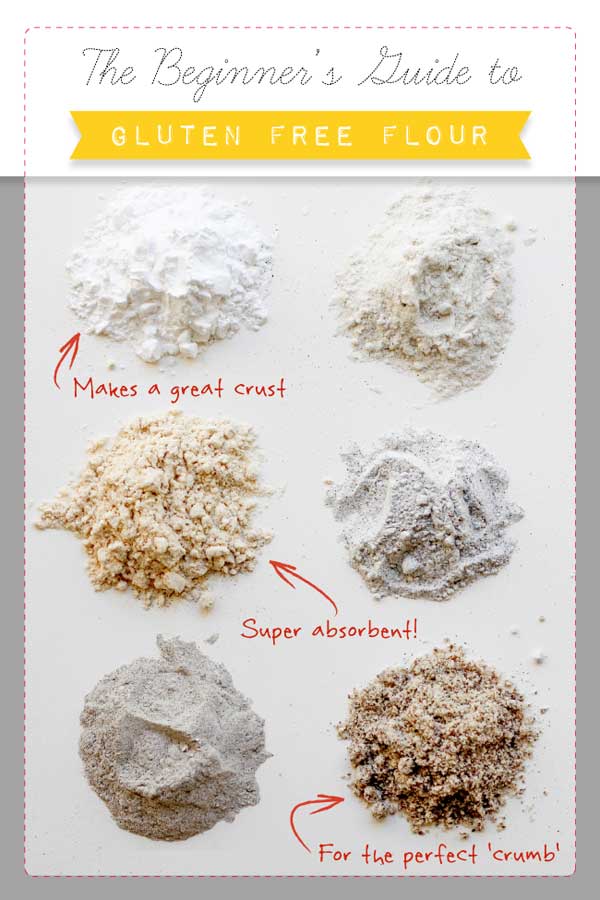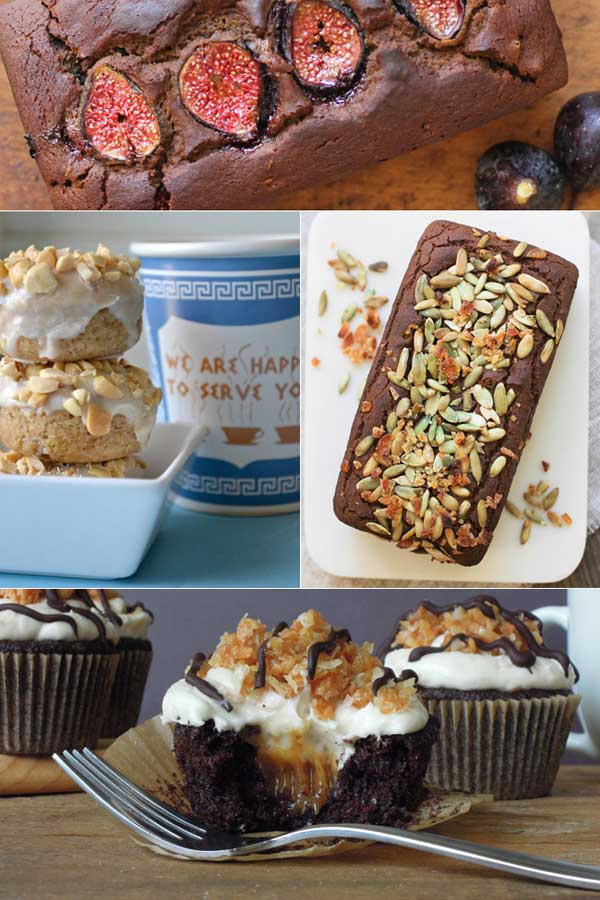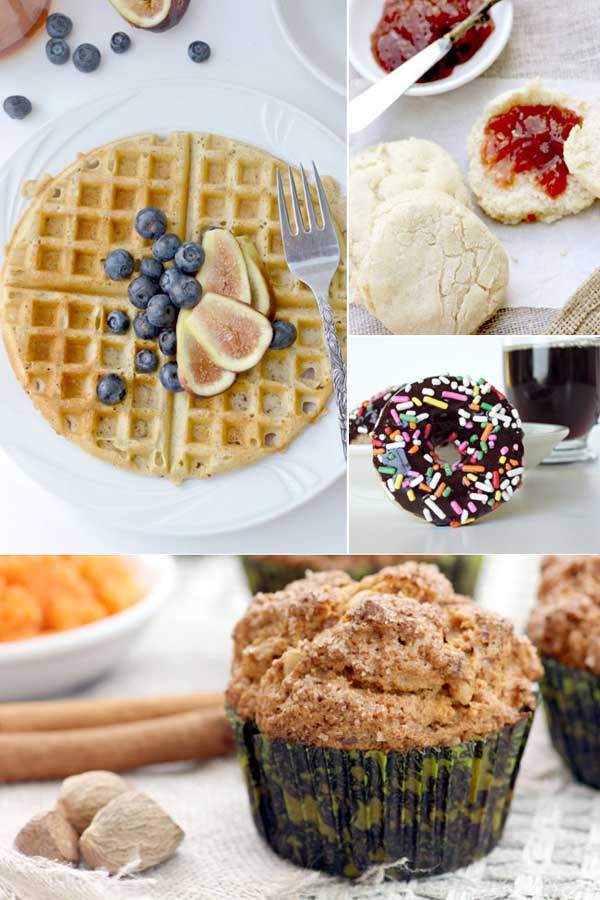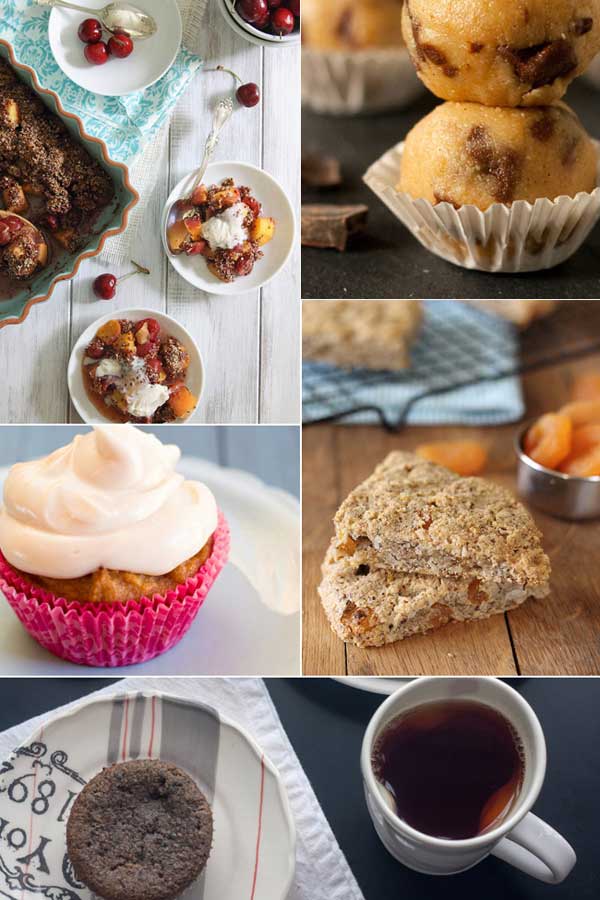Hello Potluck readers, my name is Meg and I write a little gluten-free, vegetarian blog called Beard and Bonnet. I have been cooking and eating vegetarian dishes for over 7 years, but it wasn’t until my son was born with a gluten intolerance 2 1/2 years ago that I delved into the world of gluten free cooking in our home.
As the proud daughter of a pastry chef, I always felt like I had a handle on all things baking related. I could whip up a mean batch of cupcakes or a fancy tart no problem, but when we transitioned to a completely gluten-free diet I had to relearn everything. To say I was intimidated by all of the flour choices is an understatement and when I learned that I had to create custom blends and use ingredients like xanthan gum and arrowroot powder I thought that I would never bake again.
Fast forward 2 years and I can honestly say that I still consider myself to be on the “learning curve”. In no way am I a gluten-free flour aficionado, but I have learned quite a bit through trial and error. I was very fortunate to find a group of gluten-free blogs that I really enjoyed pretty early on in our journey. These ladies sent out daily gluten-free baking inspiration to my inbox and really gave me the push I needed to start experimenting for myself again.
Consider this post a beginner’s guide to gluten-free flours; we will briefly cover whole grain flours, white flours and starches, bean flours, and nut flours. I am only covering types of flours that are readily available and that I have actually tested myself. Most all of these flours can be found at your local health food store, well-stocked grocery, or through reputable sites like Bob’s Red Mill, Nuts.com, or King Arthur Flour. You will also notice as you read through some of the inspirational recipes listed here that a lot of them use 2 or 3 of the ingredients listed in this guide and blend them together to achieve a superior gluten-free baked good. Although blending flours isn’t always necessary it is a skill that every gluten-free baker should learn. I have included a small section at the end of this guide with recipes that blend two of my favorite gluten-free flours, almond and coconut, together.
So be brave, pick a flour, an inspirational recipe, and let’s get to baking gluten-free!
Brown Rice Flour
Brown rice flour is heavier and more nutritious than white rice flour. It has a very delicate, slightly nutty flavor and is best when blended with other gluten-free flours. Brown rice flour is a terrific source of fiber, as well as protein. I suggest using brown rice flour that has been ground on very fine setting to prevent your baked goods from having a gritty texture. This is a common complaint about many brown rice flours, but I have found that this one is particularly good.
Almond and Carob Chip Biscotti | Beard & Bonnet
Maple Frosted Donuts | Fork and Beans
Homemade Gluten-Free Poptarts | Fork and Beans
Yeast Free Cinnamon Rolls | Fork and Beans
Quinoa Flour
Made from ground quinoa seeds, this flour has a mild nutty flavor that can sometimes be slightly bitter. Quinoa flour lends a nice rise to your baked goods and is great when used in recipes that call for bold flavors like cocoa that can mask the subtle bitterness. This flour is the most nutritious flour you could possibly use in baking! It has more protein than any other flour and is high in calcium, iron, zinc, and B vitamins, just to name a few.
Samoa Cupcakes | Fork and Beans
Pumpkin Muffins | Fork and Beans
Teff Flour
Officially the world’s smallest grain, Teff is primarily grown in Ethiopia where it is cultivated as a cereal crop. The tiny grains are so small that when they are milled into flour the hull is left intact rather than removed. This makes Teff flour high in protein, iron, calcium, and it contains all essential amino acids. Teff lends a subtle nuttiness and mild molasses-like sweetness to any baked good that it is used in, but is probably best known for its use in Injera bread.
Pumpkin Loaf | Beard & Bonnet
Fig Chai Tea Bread | Beard & Bonnet
Arrowroot Powder
Long ago, before Columbus, arrowroot powder was supposedly used by natives in the West Indies to draw poison out of arrow wounds. Today, this powder is used to thicken soups, roux, and pie fillings, as well as in gluten-free baked goods. To make this powder the root stalk of the arrowroot plant is dried and ground into a talcum-like powder. Arrowroot powder should not substitute directly for wheat flour in a recipe, but should be used in conjunction with other flours.
Pot Pie Cupcakes | Fork and Beans
The Perfect Waffle | Fork and Beans
Cinnamon Roll Them Nuts | Fork and Beans
Potato Starch (not flour)
Potato starch is exactly what it sounds like… starch that has been extracted from potatoes. Potato starch adds a light texture to yeast breads, muffins, and quick breads. Gluten-free cookies benefit from the addition of potato starch as well because it adds structure without the grittiness. Potato starch will help to keep all your gluten free baked goods moist and fresh. It has a mild flavor and should not substitute directly for wheat flour in a recipe, but should be used used in conjunction with other flours.
Citrus Loaf | Beard & Bonnet
Rainbow Sprinkled Chocolate-Covered Mini Donuts | Fork and Beans
Tapioca Flour (or starch)
Originally from the plant known as Cassava, tapioca starch is made when the root of the plant is boiled, dried, and then ground into a very fine powder. Tapioca flour is typically used as a thickening agent and closely resembles talcum powder in color and texture. Tapioca flour should not be substituted directly for wheat flour, but should be used in conjunction with other flours. The flavor is typically very mild and it adds a delicious, golden crust with a lighter texture to baked goods like breads and muffins.
Carrot and Coconut Muffins | Beard and Bonnet
“Faux” Buttermilk Biscuits | Beard & Bonnet
Black Bean Flour
This flour is made when black turtle beans are milled into a powder. It has a high nutritional value and should be used primarily in savory recipes unless pairing with strong flavors like cocoa in brownies. This flour can also be used as a base for black bean soup, mixed with water and spices for a quick black bean dip or filling for enchiladas. I like to add about 1/4 cup of this flour into my veggie burger base as well before forming into patties.
Savory Black Bean Flour Waffles | Beard & Bonnet
Black Bean Flour Tortillas | Beard & Bonnet
Garbanzo Bean Flour
Garbanzo beans are probably one of the world’s oldest cultivated vegetables and can be traced back at least seventy-five hundred years. Garbanzo bean flour, (AKA Besan flour, Gram flour, or Chickpea flour), is made when garbanzo beans are milled into a fine powder. This flour is high in protein and has a very distinct earthy aroma that is best utilized in savory baked goods because the flavor can sometimes be hard to mask in sweet ones. Although, when paired with pureed fruits and pungent spices this flour takes a back seat in the flavor department and lends moisture, nice texture, and rise to baked goods like muffins and breads.
Spring Onion Farinata | With Food + Love
Gluten-Free Apple Spice Cake | Tasty Yummies
Mini Kale and Onion Pizza’s | 80 Twenty
Gluten-Free Chocolate Muffins | Healthful Pursuit
Spicy Chickpea Crackers with Chives | Tasty Yummies
Leftover Cranberry Sauce Muffins | Healthful Pursuit
Kalamata Olive and Herb Socca with Roasted Vegetables | Tasty Yummies
Gingerbread Protein Pancakes | Healthful Pursuit
Almond Flour or Almond Meal
Let me start this description by noting that almond meal and almond flour are the same thing and can be used interchangeably in recipes. Almond flour is the result of grinding either raw unblanched or blanched almonds to the point that a fine powder is achieved, but not so far that it turns into almond butter. Almond flour adds a high protein content, moist crumb, and lends an amazing flavor to gluten free and grain free baked goods.
Maraschino Marzipan Kisses | Beard & Bonnet
Paleo Almond Zucchini Bread | Running to the Kitchen
Grain Free Chocolate Chip Cookie Bars | Tasty Yummies
Peach Cherry Quinoa Crumble | Running to the Kitchen
Chocolate Almond Pound Cake | Healthy Green Kitchen
Grain Free Mini Pumpkin Pie Tarts | Tasty Yummies
Peanut Butter and Chocolate Chip Cookie Dough | Texanerin
Coconut Apricot Scones | Running to the Kitchen
Black Sesame and Pear Tea Cakes | 80 Twenty
Coconut Flour
This gluten- and grain-free flour is a natural byproduct to the coconut milk making process. Much like when you make nut milks at home, a pulp consisting of bits of coconut meat are left over after pressing the milk from the coconut meat. This coconut meat is then dried at a very low temperature and ground into a soft, fine powder conducive to baking. Coconut flour is extremely absorbent and when using it in baked goods you only need about 1/4 cup of coconut flour to substitute for 1 cup of grain based flour. It is also important to note that baked goods made with coconut flour can be dense and dry, so it is important to use the appropriate amount of eggs and liquid to achieve a nice final product. Rule of thumb is 6 beaten eggs and 1 cup of liquid for every 1 cup of coconut flour used in a recipe.
Paleo Lemon Poppy Seed Muffins | A Girl Worth Saving
Grain-Free Pancakes | Nourished Kitchen
Paleo Yellow Cupcake | A Girl Worth Saving
Coconut and Almond Flour
If you have the desire to start blending flours, I suggest starting here. Coconut and almond flour work really well together and I personally love the texture and taste of baked goods that use this particular combination.
Pumpkin Date Scones | Healthy Green Kitchen
Pumpkin Paleo Pancakes | Running to the Kitchen
Grain-Free Thumbprint Cookies | Healthy Green Kitchen
Apple Muffins | Texanerin
Grain-Free Coconut Pineapple Upside Down Cake | The Nourished Kitchen
Grain Free Banana Coconut Mini Loaves | Tasty Yummies
Blueberry Almond Crumb Muffins | Nourished Kitchen
 Save Recipe
Save Recipe 




Thanks for the feature! What an awesome roundup. Seriously. I wish I had, had something like this when I went gluten-free. At the time, it was just me, my food processor and a bag of brown rice flour. Humph. This is awesome!
Thank you so much!! I am glad that you like the post and am so happy to share your recipes.
Thank you so much. Great info! I am not gluten free but some of the elder folks I cook for are and this will be helpful for me to make them some yummy foods they will love!
Thanks a ton!!
I am so glad Robin!!!
This was very helpful. I have been successful with making desserts but not so much with breads/buns. Do you have any advice for making those?
Thanks Judy! I love the Gluten-Free on a Shoestring cookbooks. There are so many delicious recipes for gluten free breads, rolls, and buns in them. Happy baking:)
This guide is SO helpful! Book marking for future reference… I dipped my toe in the g-free flour suggestions here: http://www.thecleansheep.com/2013/10/baked-apple-cider-fritters-grain-free/ 🙂
Yum! I love that you mixed almond, coconut, & garbanzo bean flour together!
Something that might help you that I have been working on. Bobs Red Mill Gluten Free Flour + Gar Gum or Xanthan gum, use regular recipes so far works pretty good. I have made pancakes, and cookies, recipes from my childhood with it and it has work well. It is also corn free. I am slowly working through other favorite recipes with it.
Thanks so much Cheryl! Bob’s Red Mill is such a fantastic brand, I am glad that you are having such success with their product.
I LOVE you for posting this!! I’ve recently embarked on the gluten-free journey, and have spent $80 on different flours and baked two failed loaves of bread. I’m SUPER excited to try these recipes!
Sandra,
I am so glad that this post has helped you! I too spent an insane amount of money in the beginning of our gluten free journey on failed attempts at baking. I feel your pain completely and hope that you find some great inspiration in all of these recipes.
Hats of to you. I do not bake. But what I learnt is you are a great mother. Also you have inspired me to be the best. I have just begun my gluten free diet, however my hypo thyroidism doesn’t leave much energy and high spirits to do things the way you do for your child. But beleive me I will try my best to do all that I can in my best, and not let me chronic devil take over me. I’m going to think of you. You have tried all the possibilties to replace gluten to make your child enjoy the best alternative food. Indeed a great mother.!! God bless you and your child.
Ash,
You are so kind, thank you very much for taking the time to comment here! I really appreciate all of your encouragement and I wish you all the best in your gluten free journey.:)
I, too, am non-Hashi’s hypothyroid, Ash, and baking is really hard…but fortunately one of my daughters rocks the gf baking when she’s at home. GF diet can be very good for people like us!
I am a little surprised that there’s no mention of buckwheat flour here. It is nutritious and very versatile, if somewhat strongly flavoured. We’ve had good results with it. It is not wheat, as I’m sure you know, but is a flower seed.
JP,
You are so lucky to have a daughter that is great gluten free baker! My daughter loves to experiment with gluten free baking as well.
I agree buckwheat flour is a great gluten free flour alternative and you are spot on about the strong flavor. That is really the only reason that I did not include it here.
I use the Jules Gluten Free flour blend, because I really don’t have time to mix my own. It is only available online and is a bit pricier than most, but it makes the most delicious baked goods. You don’t miss wheat flour at all, and there isn’t an aftertaste, as with some of the different flours I’ve tried.
Julie,
I have never tried Jules Gluten Free Flour Blend. I really like Better Batter and use it a lot though when I am not mixing my own. I will have to check out your brand.:)
What a great list!! Thank you so much for putting this out there.
We have been doing Gluten Free in our house for about 3 years now and love it. Though I’m not the greatest baker to begin with and than add no gluten.. my recipes are hit or miss.
I did notice that you didn’t have millet flour on here. Any reason why? We have a local bakery that makes A LOT of gluten free breads and their base is millet. I love the softness of the flour but not sure what to use it with all the time.
Thanks so much!
Thanks Mikki,
This list is simply a starting point with tested recipes and generally pretty easy to work with flours. I am working on a more detailed list of all gluten free flours for a future post that will definitely showcase millet flour because I love it. I just know when I was starting out it was so intimidating seeing all of the different flours listed out together. I wanted to keep it simple and informative without being too much to take in at once.:)
LOL. Sorry about that. I thought about that very thing – it being just a beginners list- after I left the comment.
You did a great job!! I’ve seen lists before but not a lot of suggestions as to what its good with.
Thank you again!
Love your web page.
Awww, thanks Mikki! No worries, it was so hard deciding what to put in this list. There are so many great gluten free flours to choose from! I wish I had a slice of the gluten free bread from that bakery you were talking about. YUM!
This is great! I normally only use nut flours and coconut flour in my gluten-free baking so that’s all I talk about on my ingredients page. I’m going to link up to this article for the people who want more info on other types of gluten-free flours. Thanks a bunch for including a few of my recipes! 🙂
Great guide! Very helpful for anyone wanting to do some GF baking. Thank you so much for putting it together for all of us! Can’t wait to explore those recipes. I’ve also included the guide in my Friday Favorites post as one of my favorite recent finds 🙂
Awesome Alexandra! I am so glad that you liked it and thank you so much for sharing. 🙂
I’m just getting started making our family homemade breads etc. Any suggestions where to start on the journey?
Hi Aimee,
Congrats on starting your gluten free journey! The best and easiest gluten free breads that I have baked all come from the cookbooks books listed below,
Gluten Free on a Shoestring
Gluten Free on a Shoestring: Quick and Easy
I hope this helps you get started!
Thanks for this. It’s a great beginner’s guide with beautiful photos. I need to get back into GF baking again this winter.
Thank you so much for this! Do you have any recommendations for breadings for frying vegetables etc? 🙂
Hi Linda, you are so welcome!! I personally use a few different types of flours for breading, depending on my mood. Lately I have been using almond flour the most though, mixed with a little gluten free all purpose flour and spices.
Thank you so much! I truly appreciate it! As a new GF gal, finding the right flours for things has been tough! 🙂
I was wondering if anyone has any recipes for Besan flour (chickpea flour) for breads and cakes. I’ve used them for flat breads but am not game to try for bread without a recipe.
This chickpea flour bread might be a place to start: http://roxanashomebaking.com/chickpea-flour-bread-recipe/
oops..I forgot to mention that I would use a GF all-purpose flour like KAF or Cup 4 Cup in place of the bread flour.
Amazing! I love this article. You have put so much work into putting this compilation together and it explains things really clearly. Thank you for sharing xx
I am so glad you like the post! Thanks for taking the time to comment.
I just found out that both hub and I are gluten intolerant. So I have been in search of gf bread recipes. The thing is, I have ordered my grains like buckwheat, millet and spelt in bulk from a mill. I am grinding them up myself. The problem is that I can’t find any recipes on line that does NOT contain either one or all of xanthum gum, potato starch or tapioca starch. I want to go back in time and bake breads from the wagon days, Aztecs or Egyptians…they didn’t use these things at all…they had never even heard of them…bc they were not created back then…it was just wholesome baking. and that is what *I* want to do. Would like some help finding recipes like that. Thank you.
Trying GF dinner rolls for the first time this weekend. Feeling over-confident I bought brown rice flour, tapioca starch and almond flour and now I am staring at them not knowing how much of each to use. Do I need a gum? What was I even thinking? Please help.
Good for you wanting to experiment Monica! Gluten free baking can be a little finicky and without testing a recipe with those particular ingredients I hesitate to tell you how much of each to use. Here are a few recipes I found online that would be a good place to start from:
http://glutenfreegirl.com/2009/11/gluten-free-dinner-rolls/
http://mygluten-freekitchen.com/pull-apart-dinner-rolls-gluten-free/
http://againstallgrain.com/2012/05/25/grain-free-hamburger-buns/
The Against All Grains post is for grain free hamburger buns, but I think they probably would work as rolls too. I hope you make the tastiest gfree rolls ever:)
You have just saved my baking life 😉
I am starting on an adventure of opening a shop that serves only organic and gluten free items from the drinks to the baked goods and let me tell you I can bake to no tomorrow but transitioning all my recipes to gluten free has given me quite the challenge!
My first two recipes were spot on for the frosting and the perfect texture but the wrong flours made it too earthy and I was looking for the perfect blends for baked goods! I’m feeling more confident than ever that I can accomplish my goal in having amazing fresh baked goods 😉